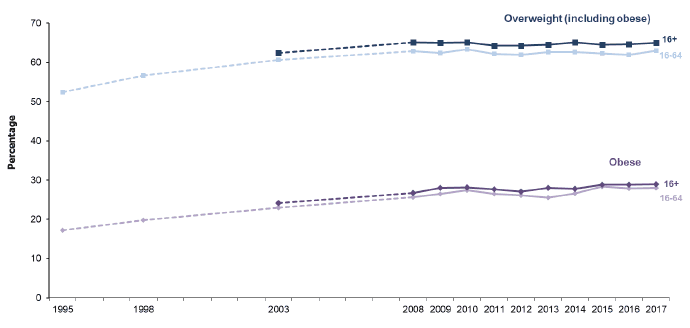Obesity indicators 2018
Latest results against the obesity indicator framework originally developed to monitor progress against our Prevention of Obesity Route Map (2010). The Route Map has now been overtaken by the Diet and Healthy Weight Delivery Plan and Active Scotland Delivery Plan published in summer 2018.
This document is part of a collection
Adult overweight and obesity
Source: Scottish Health Survey
Latest Results
- In 2017, 65% of adults aged 16 and over were overweight, including 29% who were obese.
- There has been an increase in the proportion that are overweight or obese among both sexes (aged 16-64) since 1995, from 52% to 63%. Most of this increase was seen between 1995 and 2008, with figures remaining broadly stable since then.
- Men were more likely than women to be overweight including obese (67% compared to 63%), while obesity prevalence was higher for women than men (30% compared to 27%).
- Overweight (including obesity) prevalence was lowest among young people aged 16-24 (36%). A significantly higher proportion of those aged 25-34 were overweight (55%), with further increases with age up to age 65-74. More than three quarters of those aged 65-74 were overweight including obese (78%), and all age groups above 45 (except for 75+, 68%) had a prevalence of over 70%.
Figure 1. Proportion of adults overweight and obese, 1995-2017 (ages 16-64) and 2003 to 2017 (ages 16+)

- Although inequalities in overweight prevalence vary by sex and over time, obesity rates are consistently higher in Scotland's most deprived areas compared to the least deprived (Figure 2). The gap has been particularly pronounced for women in recent years - obesity rates in 2017 were 35% in the most deprived areas compared to 20% in the least deprived.
Figure 2. Proportion of adults (16+) obese by gender and area deprivation[8], 2003-2017
![Figure 2. Proportion of adults (16+) obese by gender and area deprivation[8], 2003-2017 Figure 2. Proportion of adults (16+) obese by gender and area deprivation[8], 2003-2017](/binaries/content/gallery/publications/statistics-publication/2018/10/obesity-indicators/00542610.gif)
Definitions:
Overweight – BMI 25+
Obese – BMI 30+
Geography available: National, Health Board.
Equalities data:
Breakdowns by most equalities groups are possible. Breakdowns by age, gender and disability (limiting long term illness) are available in SHeS 2017 supplementary tables (https://www.gov.scot/Resource/0054/00540748.xls). Further breakdowns, using SHeS 2008-2011 data, are available in the topic report on equality groups published in October 2012: http://www.scotland.gov.uk/Publications/2012/10/8988
Rationale for including adult overweight and obesity:
These data are useful to monitor changes in the proportion of Scotland's adult population who are overweight and obese. Different patterns amongst men and women of different ages can be identified.
The 16-64 trend is included to allow comparisons with the 1995 and 1998 Scottish Health Surveys, as they did not collect physical activity data for all ages.
Factors influencing adult overweight and obesity:
- Diet, physical activity and sedentary behaviour are strongly associated with BMI.
- For women, obesity is significantly associated with area-level deprivation (SIMD) but not for men.[9]
Contact
Email: Xanthippi Gounari
There is a problem
Thanks for your feedback